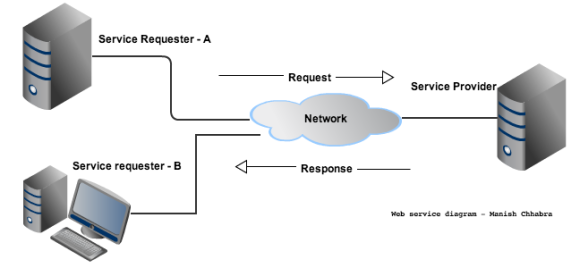What is a Web service?
A web service is a method of communication between two electronic devices over the World Wide Web.W3C defines web service as a "software system designed to support interoperable machine-to-machine interaction over a network. It has an interface described in a machine-processable format (specifically WSDL). Other systems interact with the Web service in a manner prescribed by its description using SOAP messages, typically conveyed using HTTP with an XML serialization in conjunction with other Web-related standards." [1]

What is SOAP?
SOAP is a protocol specification for exchanging structured information in the implementation of Web Services. It uses XML for the message format. It is independent of the transport protocol (could be HTTP, FTP, TCP, UDP, or named pipes).SOAP based services strictly define the format of messages passed back and forth. A SOAP message contains the data, the action to perform on it, the headers, and the error details in case of failure. Security is provided by WS-Security standards and is end-to-end. It supports identity through intermediaries, not just point to point (SSL).
SOAP provides a mechanism for services to describe themselves to clients (WSDL), and to advertise their existence (UDDI). SOAP also provides reliable messaging (WS-ReliableMessaging), that is a successful retry logic built in and provides end to end reliability through soap intermediaries.
What is REST?
Representational State Transfer (REST) is an architecture style for designing networked applications, that- Involves clients and servers sending request and responses respectively.
- Request and response are built around the transfer of representations of resources.
(e.g. request JSON representation of User)
RESTful web APIs (or RESTful web service) is a web API implemented using HTTP and principles of REST. RESTful API separates user interface concerns from data storage concerns. It improves portability of interface across multiple platforms and simplifies server components by making them stateless. Each request from client contains all the state information and server does not hold client context in the session.
SOAP vs REST?
One of the major benefits of SOAP is that you have a WSDL service description. You can pretty much discover the service automatically and generate a useable client proxy from that service description (generate the service calls, the necessary data types for the methods and so forth). Note that with version 2.0, WSDL supports all HTTP verbs and can be used to document RESTful services as well, but there is a less verbose alternative in WADL (Web Application Description Language) for that purpose.With RESTful services, message security is provided by the transport protocol (HTTPS), and is point-to-point only. It doesn't have a standard messaging system and expects clients to deal with communication failures by retrying. SOAP has successful/retry logic built in and provides end-to-end reliability even through SOAP intermediaries.
One of the major benefits of RESTful API is that it is flexible for data representation, for example you could serialize your data in either XML or JSON format. RESTful APIs are cleaner or easier to understand because they add an element of using standardised URIs and gives importance to HTTP verb used (i.e. GET, POST, PUT and DELETE).
RESTful services are also lightweight, that is they don't have a lot of extra xml markup. To invoke RESTful API all you need is a browser or HTTP stack and pretty much every device or machine connected to a network has that.
| REST | SOAP |
| Assumes a point-to-point communication model–not usable for distributed computing environment where message may go through one or more intermediaries | Designed to handle distributed computing environments |
| Minimal tooling/middleware is necessary. Only HTTP support is required | Requires significant tooling/middleware support |
| URL typically references the resource being accessed/deleted/updated | The content of the message typically decides the operation e.g. doc-literal services |
| Not reliable – HTTP DELETE can return OK status even if a resource is not deleted | Reliable |
| Formal description standards not in widespread use. WSDL 1.2, WADL are candidates. | Well defined mechanism for describing the interface e.g. WSDL+XSD, WS-Policy |
| Better suited for point-to-point or where the intermediary does not play a significant role | Well suited for intermediated services |
| No constraints on the payload | Payload must comply with the SOAP schema |
| Only the most well established standards apply e.g. HTTP, SSL. No established standards for other aspects. DELETE and PUT methods often disabled by firewalls, leads to security complexity. | A large number of supporting standards for security, reliability, transactions. |
| Built-in error handling (faults) | No error handling |
| Tied to the HTTP transport model | Both SMTP and HTTP are valid application layerprotocols used as Transportfor SOAP |
| Less verbose | More verbose |
Sent from my iPadmc
No comments:
Post a Comment